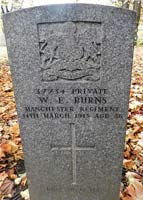
'THE GREAT WAR', 'THE WAR TO END WAR', 'WORLD WAR 1'
'What passing-bells for these who die as cattle?
- Only the monstrous anger of the guns.'
from 'Anthem for Doomed Youth'
by Wilfred Owen
CONSCIENTIOUS OBJECTION IN WW1
William Edward Burns William Edward Burns was born on March 18th 1882 at 1, Heap Street, Failsworth, son of William Henry and Anne Burns. It was a family of six children, William Edward was the third child and the only son. On August 2nd 1916 Burns appeared at Manchester County Police Court he was fined 40s and ordered to be handed over to the military authorities for failing to join the army when called up. He had not applied for a tribunal hearing and had ignored his call up papers. Once in the military he was conscripted into the 3rd Battalion of the Manchester Regiment, Private 37734, and posted to Cleethorpes where in September 1916 he was court martialled charged with “disobeying in such a manner as to show a wilful defiance of authority”, the standard charge levelled at so many conscientious objectors. He was sentenced to four months with hard labour and sent to Walton Jail. After a few weeks he accepted work under the Home Office scheme where conscientious objectors were released from prison if they agreed to join a work centre. On November 28th 1916 he was sent to south Wales where 200 conscientious objectors were forced to work in near impossible conditions on the construction of Llyn y Fan Fach reservoir. The site was at an elevation of 1200 feet and some 12 miles from the nearest railway station from where all materials and equipment had to be manhandled. The work was so challenging that the 175 Irish navvies, who had started construction in 1914, had quit the job. Many of the conscientious objectors were professional men with office jobs in peace time and totally unused to hard physical work. There is a suggestion in the records that Burns organised a strike against conditions. Around Christmas he absconded with a few others and he remained on the run for several months. It would have been a difficult time for him, he could not seek employment and it was a criminal offence to shelter a deserter, so if any of his sisters had tried to help him they would have been taking a big risk. Eventually he was forced to give himself up to the police. He was handed over to the military and returned to his regiment in Cleethorpes. Once again he refused to obey an order from an officer and at a court martial on November 8th he was sentenced to 2 years with hard labour. He was received into Hull Prison on November 16th 1917. A medical examination found him to be in good health both physically and mentally, he was 5 ft 1 in tall and weighed 8 sts 5lbs. As with all men starting a sentence with hard labour, he was put into a small cell where he would be confined without exercise for the first month and for the first two weeks there was only a board to sleep on. Burns was put to oakum picking but he refused to co-operate. Alfred Hughesdon, governor of the jail, ordered him to have three days on a punishment diet, loss of prison privileges and the loss of eleven days remission. On the second day of the punishment diet he started to work. In January 1918 Burns wrote a letter upon hearing of the death of a friend from Stockport, ”I must candidly admit that it is preferable to this sordid existence. I think it is the only thing that can give us liberty. I am not getting pessimistic but I feel many times that death is a great deliverer from things worse than that.” The governor reported to the prison doctor, Dr Edmund Henry Howlett, that Burns’ state of mind might be affected but the doctor certified that he was in good health. Later, in another letter, Burns wrote, “I am sorry to admit that something is having an effect on me physically. For many weeks I have been shaky on my legs and suffer from pains on my left side. I get little sleep but am continually twisting and turning about.” The governor intercepted this letter and considered the statements were exaggerated because he had received another certificate from the doctor just a day or so previously stating that Burns was in good health. Prison rules stipulated that letters could not be sent which might alarm relatives and friends, so Burns had to resubmit the letter and he wrote he was “falling to pieces”. He also sent at least two letters to Annie Pimlott of the No-Conscription Fellowship and received replies from her, they addressed each other as “Dear Comrade”. Annie showed the letters she received to a solicitor who wrote to the governor about Burns’ situation. Burns’ health continued to decline. He weighed just 8 stones, his legs were still weak, the pains in his side persisted and but the governor and Dr Howlett, were unsympathetic. Questioned at a later enquiry about Burns’ condition during February the doctor said he tested his reflexes and found them normal. A few days later the legs were no better and he still complained of sleeplessness, “these men complain of so many things” said the doctor. Dr Howlett also remarked that Burns looked anaemic but said most conscientious objectors had the same appearance, “they are anaemic in their brains,” he added. Burns twice petitioned the Home Office, first to be reinstated into the Home Office Scheme which would mean he could take work outside prison as he had done in south Wales (although no doubt hoping for something less onerous) and on the second occasion to be granted temporary release under what was known unofficially as the Cat and Mouse Act. Properly called the Prisoners (Temporary Discharge for Ill-health) Act, it was introduced in 1913 to deal with Suffragettes, it allowed for the early release of prisoners who were so weakened by hunger striking that they were at risk of death. They were sent home to recover and recalled to prison once their health had improved, where the process would begin again. On Friday March 8th 1918, unhappy that nobody in authority was taking any notice of his health problems, Burns refused food. On Sunday the 10th Doctor Howlett signed a certificate to allow forcible feeding to commence, he was to be assisted by a male warder and a female nurse. The fluid was administered every twelve hours through a nasal tube which, tragically, proved to be too short. In spite of the fact that Burns choked and gasped for air, the feeding continued. He was moved to a larger cell and given a bedstead and mattress, small wonder he had previously suffered sleeplessness without these simple comforts. On March 12th Burns requested that his mother be allowed to visit him, the governor contacted the Home Office and in reply received a telegram just before midnight on March 13th:
Events overtook them, a few hours later at 4.40 a.m. on the morning of Thursday March 14th 1918, Burns died. He was the first person to be force fed in Hull Prison. Governor Hughesdon informed the Home Office of the death and enclosed Dr Howlett’s report written immediately after the death.
His mother and one of his sisters arrived two days after he died perhaps to attend the funeral. Alfred Boosey, a fellow conscientious objector, from Halifax, petitioned the governor to be allowed to communicate by telegraph with the legal representative of the No-Conscription Fellowship in London but this was denied. An inquest was held in Hull on March 21st and 22nd. Witnesses were the governor, the doctor, a warder and a nurse. Another conscientious objector, William Ewart Hopper of Jarrow, also gave evidence. He stated that Burns had complained of his legs and from February 11th onwards had become decidedly worse. He had lost weight and was very weak. Hopper also said that Burns had told him that he held a conscientious objection to joining the military because he was an atheist and an anarchist. The jury’s verdict was that death was due to pneumonia, accelerated by the inhalation of some fluid food during forcible feeding but they were of the opinion that there was no blame attached to the prison governor or Dr Howlett and that if Burns had not been fed he would have died of starvation. It was noted that this was the first time Dr Howlett had been involved in force feeding. Death had occurred because the nasal tube was too short allowing the liquid feed to enter Burns’ lungs causing pneumonia to develop. The inquest was held over two days, it was reported in newspapers all over the country. The death caused consternation in official circles, including in Parliament where questions were asked. Just six months previously, Irish Republican Thomas Ashe had died in Dublin’s Mountjoy Prison after being forcibly fed by the British Authorities. The brutality of forcible feeding caused an outcry, the British were accused of murder and the death served to recruit more people to the cause of Irish independence. Thousands lined the streets of Dublin for the funeral. It was feared that the death of William Edward Burns in similar circumstances, with the inquest widely reported in newspapers, would draw public opinion in England towards the cause of conscientious objection. After Ashe’s death, forcible feeding was stopped in Ireland but continued for conscientious objectors throughout World War One. Although it was officially viewed as a way of saving life, it was also seen as a disciplinary measure and a deterrent. An official enquiry into Burns’ death and the subject of force feeding in general was ordered to be conducted by eminent surgeon Sir William Watson Cheyne and Maurice Craig, a consultant psychologist at Guy’s Hospital. They met during the week before the inquest. The report was not made public at the time. They concluded that there were no regulations under the Prison Act with regard to artificial feeding but the Medical Officer should have the general care of the health of prisoners.
William Edward Burns was buried by the Commonwealth War Graves Commission in Grave 16.67, Hedon Road Cemetery, Hull. The cemetery is next to the prison and his grave not far from the prison wall. Contributed by Dorothy Bintley ~~~~~~~~~~~~~~~~~~~~~~~~~~~~~~~~~~~~~~~~~~~~~~~~~~~~~~~~~~~~ Image links |
Return
to Local Conscientious Objectors
If you can add to our information about any of the local Conscientious Objectors in WW1 we would love to hear from you.
Email ![]()
If you have Oldham and District items that we can include on our website, PLEASE visit the information page to find out how you can help.


